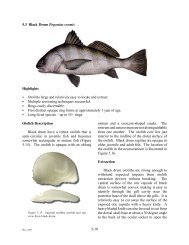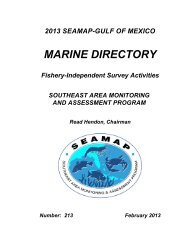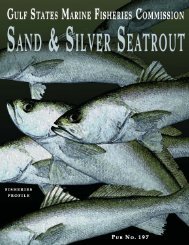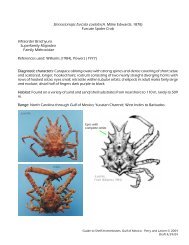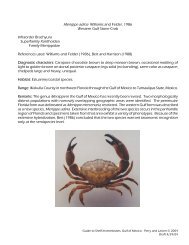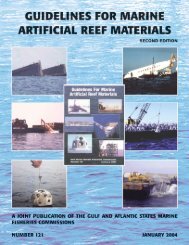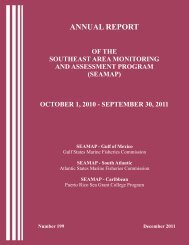Basic Commercial Fishing Regulations - Gulf States Marine ...
Basic Commercial Fishing Regulations - Gulf States Marine ...
Basic Commercial Fishing Regulations - Gulf States Marine ...
You also want an ePaper? Increase the reach of your titles
YUMPU automatically turns print PDFs into web optimized ePapers that Google loves.
Boating Information<br />
30<br />
Rules of the Road<br />
The following regulations shall dictate<br />
the operation of vessels upon the<br />
waters of the state and shall set forth<br />
a standard of operation. In construing<br />
and complying with these rules, due<br />
regard shall be had to all dangers of<br />
navigation and collision and to any<br />
special circumstances, including the<br />
limitations of the vessels involved,<br />
which may make a departure from the<br />
rules necessary to avoid immediate<br />
danger.<br />
1. Vessels passing head-on shall<br />
each keep to their respective<br />
right.<br />
2. A vessel overtaking another vessel<br />
may do so on either side, but<br />
must grant the right-of-way to<br />
the vessel being overtaken.<br />
3. When vessels are passing at right<br />
angles, the vessel on the left will<br />
yield right-of-way to vessel on the<br />
right.<br />
4. Motorboats shall yield right-ofway<br />
to non-motor powered boats<br />
except as follows:<br />
A. When being overtaken by<br />
non-powered vessels.<br />
B. For deep draft vessels that<br />
have to remain in narrow<br />
channels.<br />
C. When vessel is towing<br />
another vessel.<br />
5. Motorboats must maintain a<br />
direct course when passing sailboats.<br />
6. A vessel approaching a landing<br />
dock or pier shall yield the rightof-way<br />
to any departing vessel.<br />
7. A vessel departing shoreline or<br />
tributary shall yield right-of-way<br />
to through traffic and vessels<br />
approaching shoreline or tributary.<br />
8. Vessels will not abruptly change<br />
course without first determining<br />
that it can be safely done without<br />
risk of collision with another vessel.<br />
9. If an operator fails to fully comprehend<br />
the course of an<br />
approaching vessel he must slow<br />
down immediately to a speed<br />
barely sufficient for steerageway<br />
until the other vessel has passed.<br />
10. Vessels yielding right-of-way<br />
shall reduce speed, stop, reverse<br />
or alter course to avoid collision.<br />
Vessel with right-of-way shall<br />
hold course and speed. If there is<br />
danger of collision, all vessels<br />
will slow down, stop or reverse<br />
until danger is averted.<br />
11. Vessels will issue warning signals<br />
in fog or weather conditions<br />
that restrict visibility.<br />
12. No mechanically propelled vessel<br />
shall be operated so as to traverse a<br />
course around any other vessel<br />
underway or any person swimming.<br />
13. In a narrow channel, vessels will<br />
keep to the right of mid-channel.<br />
14. Vessels approaching or passing<br />
another vessel shall be operated<br />
in such manner and at such a rate<br />
of speed as will not create a hazardous<br />
wash or wake.<br />
15. No vessel shall obstruct or interfere<br />
with take-off, landing or<br />
taxiing of aircraft.<br />
16. All vessels shall be operated at<br />
reasonable speeds for given conditions<br />
and situations and must<br />
be under the complete control of<br />
the operator at all times.<br />
17. No person shall, under any circumstances,<br />
operate a vessel in<br />
excess of an established speed or<br />
wake zone.<br />
18. No vessel or person shall obstruct<br />
or block a navigation channel,<br />
entrance to channel, mooring<br />
slip, landing dock, launching<br />
ramp, pier or tributary.<br />
19. Vessels shall keep at least 100<br />
feet clearance of displayed diver’s<br />
flag.<br />
20. Operator shall maintain a proper<br />
lookout.<br />
NOTE: For a more comprehensive<br />
compilation of boating and vessel<br />
requirements, see the LDWF website<br />
at www.wlf.louisiana.gov for a printable<br />
version of “Handbook of LA<br />
Boating Laws and <strong>Regulations</strong>.” For<br />
more information on boating regulations<br />
or safe boating courses visit the<br />
LDWF website or phone 225-765-<br />
2984.<br />
80<br />
Safety Tips<br />
Filing a float plan<br />
• Before going out on a vessel<br />
it is always a good idea to<br />
leave a float plan.<br />
• Leave it with a relative or<br />
friend.<br />
• A float plan should describe<br />
the vessel, its registration<br />
number, size, hull color and<br />
engine type. Note the boat<br />
landing that is to be used to<br />
unload the boat and the area<br />
where you intend to fish<br />
with names of lakes and<br />
bayous, etc.<br />
• List the number and names of<br />
passengers and any cell phone<br />
numbers and VHF radio call<br />
sign of the vessel.<br />
Falls Overboard<br />
• Don’t stand in a moving<br />
boat.<br />
• Don't sit on gunwales, seatbacks<br />
or bow area of the<br />
boat.<br />
• Don’t lean over the side for<br />
any reason.<br />
• Always hold on to something<br />
when moving in a stationary<br />
boat and never move<br />
about in a boat when it is<br />
underway.<br />
• Always wear a personal flotation<br />
device when the boat<br />
is underway.




